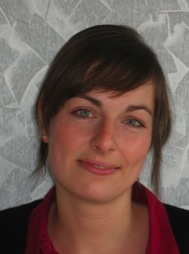The overall topic of my research is cellular response to patterned biointerfaces. In particular, I work with two novel UV-curable biomaterials, i.e. a hydrophobic fluoropolymer (perfluoropolyether, PFPE) and a bulk polyethylenglycol (PEG) based hydrogel. Both materials are, due to their chemical characteristics, inert to cell adhesion. Our results have shown, however, that micrometer-sized topographic patterns on the materials’ surface elicit strong cellular responses, i.e. cells (murine fibroblasts) do adhere, spread and align along the geometries. In addition to the variation of surface topography the stiffness of the substrates is tuned by changing the cross-linking density of the polymers and a marked dependence of cell behavior on the hydrogel’s rigidity is observed.
Besides the investigation of cell adhesion and spreading ON surface topography we are also studying how cells behave INSIDE hydrogels. By uniaxial freezing, we have created regular µm-sized (5 -15 µm diameter) channel structures within soft PEG-based hydrogels and we are investigating the proliferation and migration of fibroblasts through those channels, which are intrinsically non-adhesive. These substrates do not only allow fundamental studies of cellular behavior in 3D but also bear great potential for the use in medical applications.
So far, my work has concentrated mainly on morphological and structural aspects of cells, e.g. shape and cytoskeletal organization. Currently, I am focusing more on biochemical and molecular aspects, e.g. production, deposition and remodeling of the ECM in response to the 2D or 3D environment. By means of immuno-staining different molecules involved in cell adhesion –inside of the cell and adsorbed to the substrates- are localized (e.g. Vinculin, Paxillin, Fibronectin). Gene expression studies (real-time PCR) are used to investigate substrate-induced changes in the ECM.
Graduiertenkolleg GRK 1035/2 "Biointerface - Detektion und Steuerung grenzflächeninduzierter biomolekularer und zellulärer Funktionen" (August 2007 - December 2008)
http://www.grk-biointerface.de/index.php
„Surface topography induces fibroplast adhesion and spreading on two intrinsically non-adhesive Biomaterials“
Gordon Research Conference "Signalling by Adhesion Receptors", July 2008, Holyoke, USA
BIO & Polymers Biannual Meeting of the GDCh-Division "Macromolecular Chemistry", September 2008, Aachen, Germany
Gordon Research Conference "Signalling by Adhesion Receptors", July 2008, Holyoke, USA
World Biomaterial Congress, May 2008, Amsterdam, The Netherlands
Internal Colloquium Biointerface, June 2008, Rolduc, The Netherlands
Internal Colloquium of the Graduiertenkolleg Biointerface, October 2007, Rolduc, The Netherlands
NanoBIO Europe, May 2007, Münster, Germany
Poster award
BIO & Polymers Biannual Meeting of the GDCh-Division "Macromolecular Chemistry", September 2008, Aachen, Germany
Description of work

Vera Schulte
Position PhD student (Biotechnology)
Project Cellular reactions to patterned Biointerfaces
Contact schulte@dwi.rwth-aachen.de
Research Interests contact guidance
mechano transduction
cell culture
immuno-staining
ECM production
protein adsorption
Scholarship
Posters
Awards
Talks